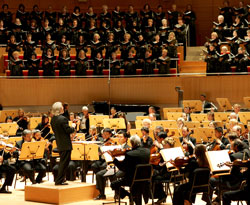 Arvo Pärt: Symphony No. 4
Arvo Pärt: Symphony No. 4
Los Angeles Philharmonic, Esa Pekka Salonen conductor
Estonian Philharmonic Chamber Choir, Tõnu Kaljuste conductor
Symphony No. 4 “Los Angeles” (2008)
Fragments from Kanon Pokajanen (1997)
ECM New Series 2160
 Estonian composer Arvo Pärt turned 75 yesterday. His record label ECM Records is celebrating his three-quarters of a century with two new recordings.
Estonian composer Arvo Pärt turned 75 yesterday. His record label ECM Records is celebrating his three-quarters of a century with two new recordings.
Pärt’s 4th Symphony is a long-anticipated follow-up to his 3rd – which was written back in 1971! In the interim, the composer has moved from a modernist style to an idiosyncratic version of minimalism; one the composer calls the “tintinnabuli” style of composition. From bell-like resonances and slowly moving chant melodies, Pärt has crafted a personal compositional language of considerable appeal. And while this has included a number of stirring instrumental works, such as Tabula Rasa and Cantus in Memory of Benjamin Britten, more recently Pärt has been known for his choral music. His return to symphonic form is thus an opportunity to explore his mature language in a different milieu.
Perhaps in part as an acknowledgement of the home of the orchestra commissioning the Fourth Symphony – the “City of Angels” – Pärt decided to use a text as a formative – if subliminal – device in his preparations of the piece: the Canon of the Guardian Angel. Thus, while this is certainly not merely a transcription of a vocal piece – it sounds idiomatic and well orchestrated – there is a certain chant-like quality which demonstrates the symphony’s affinity with the vocal music and chant texts that are Pärt’s constant companions.
The live recording is of the work’s premiere in Disney Hall in LA. Salonen and the LA Phil give a muscular rendition of the piece, emphasizing its emphatic gestures while still allowing for the symphony’s many reflective, meditative oases to have considerably lustrous resonance. And while one can certainly hear a palpable connection to Pärt’s chant-inspired tintinnabuli pieces, the symphony also allows for dissonant verticals and melodic sweep that recalls both Pärt’s own Third Symphony and the works of other 20th century symphonists, from Gorecki to Shostakovich.
Perhaps in order to clearly attest to the connection between text and symphony, the disc is balanced out with a fifteen-minute serving of fragments from one of his important choral works from the 1990s: Kanon Pokajanen. The composer has pointed out the relationship between the canon that was his reference point for the symphony and the texts upon which the latter choral work was based.
He says, “To my mind, the two works form a stylistic unity and belong together. I wanted to give the words an opportunity to choose their own sound. The result, which even caught me by surprise, was a piece wholly pervaded by this special Slavonic diction found only in church texts. It was the canon that clearly showed me how strongly choice of language preordains a work’s character.”
Kaljuste and the Estonian Chamber Choir are seasoned handlers of Pärt’s works, having made a number of recordings of his music. They do not disappoint here, providing a performance that juxtaposes the ethereal eternity found in the texts with an earthy and corporeally passionate rendering of the music.
_____________________________________________
In order to further fete Pärt, ECM also plans a lush reissue of their landmark 1984 recording, Tabula Rasa, complete with a generous accompanying book with newly commissioned essays about the composer.






 For four weeks beginning October 12, 2010 at noon, remixers can visit Indaba’s
For four weeks beginning October 12, 2010 at noon, remixers can visit Indaba’s  Arvo Pärt: Symphony No. 4
Arvo Pärt: Symphony No. 4 Estonian composer Arvo Pärt turned 75 yesterday. His record label ECM Records is celebrating his three-quarters of a century with two new recordings.
Estonian composer Arvo Pärt turned 75 yesterday. His record label ECM Records is celebrating his three-quarters of a century with two new recordings.